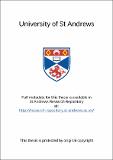Influence of cysteine residues on monoamine oxidases catalysis
Abstract
Monoamine oxidases (MAO), types A and B, are flavin-containing enzymes important in the regulation of biogenic amines, including the neurotransmitters, serotonin and dopamine. Cysteine modification inactivates MAO and alters the flavin redox properties, yet the crystal structure has shown that there are no conserved cysteines in the active site of MAO B and that the cysteine 365, modified after inactivation by a cyclopropylamine, was on the surface. The aim of this project was to find how the cysteine residues influence MAO catalysis. MAO A and B cysteine mutants to alanine were constructed and expressed in P. pastoris. MAO A C374A was purified and characterised kinetically. The mutant was active but had decreased Kcₐₜ/kₘ values with a series of substrates compared to the native enzyme. The Kᵢ values for inhibitors were not changed. Mechanism-based inactivators, cyclopropylamines, showed the same pattern as the substrates. Spectra studies and free thiol counts established that 1-phenylcyclopropylamine (1-PCPA) forms a flavin adduct whereas 2-phenylcyclopropylamine (2-PCPA) and A-cyclo- α-methylbenzylamine (N-CαMBA) form adducts with a cysteine in both native and mutant MAO A. Thus, the cysteine modified by N-CαMBA in MAO A is not the 374, as it would be expected by correspondence to the MAO B cysteine 365. For the 1-PCPA and N-CαMBA, the partition ratio was decreased by more than 50%. The data suggest the mutation of cysteine 374 decreases the efficiency of MAO A catalytic process without affecting the ligand binding. A revised mechanism for inactivation of MAO by cyclopropylamines is proposed.
Type
Thesis, PhD Doctor of Philosopy
Collections
Items in the St Andrews Research Repository are protected by copyright, with all rights reserved, unless otherwise indicated.

